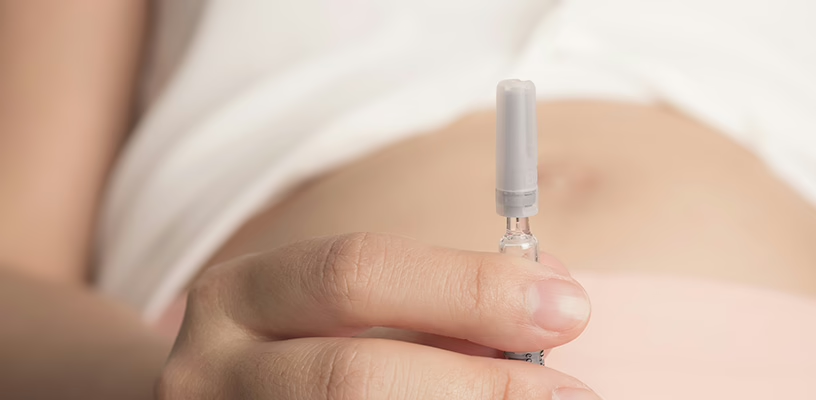Intrauterine Insemination (IUI) Fertility Treatment: Procedure, Success Rates, Costs, and Risks
If you’ve been trying to get pregnant for months (or years) without success, you may want to consider intrauterine insemination (IUI).

Intrauterine insemination offers hope for many couples dealing with infertility. However, it can be confusing, especially if you’re already feeling overwhelmed by the exhausting process of trying to get pregnant.
To make things easier, here’s a guide to IUI. We’ll go over how it works, as well as its benefits, risks, and cost.
What is IUI?
Intrauterine insemination is a fertility treatment where your doctor injects sperm (either from your partner or a donor) directly into your uterus.
It’s a popular first-line fertility treatment for many couples, as it’s not as invasive as in vitro fertilization (IVF), which involves removing your eggs from your body, fertilizing them, and re-implanting them. 1 2
How IUI works
Your doctor will perform IUI when you’re ovulating (when an egg gets released from your ovary for fertilization). They’ll either follow your natural menstrual cycle or use fertility medications to trigger ovulation, depending on what type of infertility you’re struggling with and the regularity of your cycle.
Once they’re sure you’re ovulating, your doctor will run the sperm through a special process called “sperm washing,” which involves taking a sperm sample, mixing it with a special solution, and spinning it around to separate healthy sperm from the rest of the semen. 3 4
They’ll then use a thin tube (about the size of a spaghetti strand) to inject those millions of sperm into your uterus. 1 5
How IUI differs from natural fertilization
During natural fertilization, sperm enter your vagina and swim through your cervix into your uterus, up one of your fallopian tubes, and then to the top of your tubes where the egg is waiting to get fertilized. 6
With IUI, you’ll have a better chance of conceiving, because the procedure helps specially prepared sperm bypass your cervix, increasing the concentration of healthy sperm that reach your egg.
Why your doctor may recommend IUI
IUI can be helpful if you have certain fertility issues, such as cervical scarring or mucus that’s too thick for sperm to reach the egg. It’s also useful if you want to use donor sperm (e.g., if you’re single, part of a same-sex couple, or are hesitant about passing on a genetic condition).
Your doctor may also recommend IUI if you’re struggling with: 7 8 2 1 9
- Your partner’s infertility: IUI can help if your partner has issues impeding your fertility as a couple, such as a physical disability, erectile dysfunction, premature ejaculation, mildly (but not severely) low sperm count, or poor sperm shape or movement.
- Irregular ovulation: Your doctor may combine IUI with fertility medications to stimulate egg production and improve your chances of conception if you have fewer eggs or you have absent or irregular ovulation, such as if you have polycystic ovary syndrome (PCOS).
- Semen allergy: While this is rare, being allergic to your partner’s semen can make unprotected sex uncomfortable. Because IUI involves “washing” the sperm in a special process that removes many potential allergy-causing proteins, it can help with this. 10
An active infection may make IUI nonviable
Your doctor won’t perform an IUI if you have an ongoing infection in your pelvis, uterus, or cervix. This is especially true if they see anything alarming during the IUI procedure, like unusual discharge.
How successful are IUI treatments?
A single round of IUI treatment has a 5%–20% chance of success. The odds depend on your age, health, and the quality of the sperm you’re using. 1
With unexplained infertility, your success rate per cycle will be around 10%–12% if you’re under 35 years old or around 5–8% if you’re 35–40 years old. 11 If you’re using donor sperm or your infertility is due to a low sperm count on the part of your partner, you can expect the success rate to be higher, around 15%–20% per treatment.
How much does IUI cost compared to other fertility treatments?
Usually, IUI treatments are one of the cheapest fertility-assisting procedures, costing $500 to $4,000 per round of treatment. 12 13 That’s why many people try IUI first, before other treatments like IVF. 1
As with many treatments, the price of IUI varies from clinic to clinic. You might end up paying more for IUI if you need donor sperm, multiple rounds of treatments, or medication to stimulate ovulation or boost your fertility in other ways.
To see how IUI costs stack up against other common treatments, check out the table below: 12 13 14 15 16 17 18
| Treatment | Procedure | Cost per treatment cycle |
|---|---|---|
| Intrauterine insemination (IUI) | - Sperm is injected directly into your uterus | $500 to $4,000 |
| In vitro fertilization (IVF) | - Your doctor removes mature eggs from your ovaries - Eggs are mixed with sperm in a lab dish to fertilize them - Your doctor implants the fertilized eggs in your uterus |
$12,000 to $30,000 |
| Intracytoplasmic sperm injection (ICSI) | - Your doctor removes mature eggs from your ovaries - Your doctor individually injects each egg with a single sperm - Your doctor implants the eggs in your uterus |
$800 to $3,000* |
| Frozen embryo transfer (FET) | - Your doctor takes a frozen embryo from a previous IVF cycle - They thaw it and transfer it into your uterus |
$3,000 to $7,000* |
* Note that ICSI and FET are extra services that may be performed in addition to IVF, not entirely separate procedures. This means that you’ll need to pay their costs per treatment cycle on top of (not instead of) the cost of IVF.
The good news is that your insurance plan may fully or partly cover a lot of these procedures. Still, it’s always best to check in with your provider first.
What will happen during your IUI treatment?
IUI is usually broken down into three stages:
1. Initial consultation and testing
When you first go to the clinic, your doctor will conduct a comprehensive health evaluation, which involves reviewing your medical history, physical exams, and fertility tests (for both you and your male partner, if you have one).
Clinics will usually conduct: 19
- Semen analyses
- Blood tests to assess your hormone levels and screen for infections
- Uterine ultrasounds called saline infusion sonograms (SIS) or sonohysterograms 20
- X-rays, called hysterosalpingograms (HSGs), to ensure your fallopian tubes are open. 21
2. Ovulation monitoring and stimulation
Your doctor will need to wait for the perfect time to conduct the procedure: when you’re ovulating.
Timing your ovulation requires careful monitoring. This can be done with different tools: 22 23 24 7
- Ovulation predictor kit (OPK): These tests come with strips or dipsticks that use your urine to detect spikes in luteinizing hormone (LH), as an LH surge occurs when you’re ovulating. To use an ovulation test strip, you’ll pee on the strip and wait to see if the test line becomes darker than the control line. 25
- Blood test: Your doctor can look at your blood for hormone surges to track your ovulation.
- Transvaginal ultrasound: Your doctor will insert a probe into your vagina to visualize your ovaries and monitor your egg development.
When and why your doctor may use fertility medications with IUI
Your doctor will probably go the natural route if you don’t need help with ovulation, such as if you’re pursuing IUI because you’re single, part of a same-sex female couple, or part of a couple dealing with male infertility. 11
However, if you’re dealing with fertility or ovulatory issues of your own, they’ll use fertility medications to stimulate your ovaries to release eggs.
3. Sperm preparation
On the day of your IUI procedure, your doctor will prepare the sperm they’ll inject.
If you have a partner, he’ll provide a fresh semen sample. Note that he shouldn’t ejaculate at least 24 hours before he gives this sample. 23
If you’re using a donor, the sample will be frozen ahead of time. Your doctor will thaw and prepare it before the procedure.
The sperm sample will undergo a 20-minute “sperm washing,” which uses a specially formulated solution to separate the best sperm from the rest of the semen and to boost the sperm’s movement, lifespan, and ability to reach and fertilize your egg. 26 23
4. Insemination
The actual insemination part of the procedure is quick and relatively painless.
First, you’ll lie on an examination table and your doctor will insert a speculum (a duck-bill-shaped tool) into your vagina to look at your cervix, similar to when you get a Pap smear. Afterward, they’ll pass a thin, small tube through your cervix and into your uterus.
They’ll then slowly inject the prepared sperm directly into your uterus. While this is usually painless, you might feel a little cramping when your doctor injects the sperm.
5. Post insemination
After the procedure, your doctor will carefully remove the tube and speculum. You’ll then need to lie down for a short period (around 10–20 minutes) to give the sperm time to swim up your fallopian tube and reach your egg. 27 28
Your doctor may prescribe supplements for progesterone and, in some cases, estradiol to support the lining of your uterus and improve the chances of a fertilized egg implanting there.
You can take progesterone vaginally or by injection (intramuscularly), and you can take estradiol orally, vaginally, intramuscularly, or transdermally (via a skin patch, gel, or spray). 29
What to expect after your IUI treatment
Usually, you’ll be able to get back to your normal routine afterward. Sex is still on the table, too—although you may need to wait 48 hours if you had any bleeding during the procedure or if your doctor used a tenaculum (a type of forceps). 23
Note that you may have some light spotting for one or two days after.
What are the risks of IUI treatment?
Generally, IUI is a low-risk procedure, but there’s a very small chance of bacteria being introduced into your uterus during the procedure. 29 Call your doctor immediately if you develop a fever, chills, pelvic pain, or notice foul-smelling vaginal discharge. 30
Most of the other risks of the treatment come from the use of the fertility drugs that we mentioned. These medications stimulate your ovaries and could make them produce multiple eggs, which, in turn, may lead to: 31 23 7 29
- Multiple babies: If your fertility medications make your ovaries release more than one egg, you have around a 5% chance of ending up with twins, triplets, or more. 11 While this isn’t in itself a bad thing (perhaps you’re even excited about having multiples), it comes with increased health risks for both you and your babies.
- Ovarian hyperstimulation syndrome (OHSS): Fertility drugs can sometimes overstimulate your ovaries, which may cause pain in your belly, nausea, vomiting, constipation, and decreased urination. There may also be fluid retention in the form of cysts that can last for weeks or a month or two, but will usually go away on their own.
- Treatment cancellation: You may produce too many eggs, or you may have a negative reaction to the fertility medications. In that case, your doctor may need to cancel the treatment cycle.
- Mood changes: Another possible side effect of fertility drugs is mood changes. You may feel a little down or irritable while you’re on your meds. If this affects your quality of life, you may need to switch to a different kind.
How long until you can take a pregnancy test after IUI
After your procedure comes the dreaded two-week wait (the time it normally takes before getting a positive result on your pregnancy test). This will last until the date of your next expected period.
If you miss your period, you can take an at-home pregnancy test to confirm if you’re pregnant, although a blood test at your doctor’s office will be more accurate.
If the test is positive, your doctor will monitor your pregnancy with blood tests and ultrasounds to ensure everything is progressing as expected.
What happens if you get a negative result
A negative pregnancy test after IUI can be disheartening. Your doctor will discuss your options, which may include another IUI cycle or exploring alternative fertility treatments like IVF.
Most clinics recommend trying three to six IUI treatments or “cycles” before considering other options. However, this may vary depending on your health circumstances and age.
What to do in the two-week waiting period
Most importantly, you need to follow your doctor’s instructions. Stick to whatever medications they prescribe and discuss your concerns with them if you feel that you can’t.
In between visits with your doctor, you should:
- Maintain a healthy lifestyle: Eating a balanced diet, getting regular exercise, and working on your stress management techniques are the keys to a successful IUI treatment.
- Avoid bad habits: You should also avoid smoking, drinking, and using recreational drugs. Don’t consume more than 12 ounces of caffeinated beverages (about 1.5 cups of coffee) per day. 23
- Avoid certain medications: Don’t take aspirin or ibuprofen (Motrin or Advil). Tylenol is okay. You should also cut out herbal products and supplements, including soy (talk to your doctor to confirm exactly what is and isn’t safe for you to take during this period).
If you’ve been constantly disappointed while trying to get pregnant, it’s understandable to feel a little defeated. Try to keep a positive attitude. It can go a long way in helping you cope with all the obstacles you’ve powered through so far.
Final thoughts
If you’re struggling with infertility, IUI is a less invasive and more affordable option than IVF. While it isn’t foolproof, it could be a great tool for starting your family.
Throughout the process, your doctor will be by your side, and with their support, you may finally achieve your dream of becoming a parent.
Article Sources
- Penn Medicine. "Intrauterine insemination (IUI)" Retrieved August 6, 2025.
- NewYork-Presbyterian Hospital. "Intrauterine Insemination (IUI)" Retrieved August 6, 2025.
- Sperm Bank Inc.. "Fertility Services" Retrieved August 6, 2025.
- The Fertility Center of Oregon. "Sperm Washing and Intrauterine Insemination (IUI)" Retrieved August 6, 2025.
- UT Health San Antonio. "Intrauterine Insemination" Retrieved August 6, 2025.
- University of Michigan Center for Reproductive Medicine. "Frequently Asked Questions of the ART Laboratory" Retrieved August 6, 2025.
- UW Medicine. "Gonadotropin / Intrauterine Insemination (IUI)" Retrieved August 6, 2025.
- Columbia Doctors. "Intrauterine Insemination (IUI)" Retrieved August 6, 2025.
- Mount Sinai Fertility. "Intrauterine Insemination" Retrieved August 6, 2025.
- Johnson Memorial Health. "Semen allergy: A cause of infertility?" Retrieved August 6, 2025.
- The UCSF Center for Reproductive Health. "Intrauterine Insemination (IUI)" Retrieved August 6, 2025.
- Fertility IQ. "The Cost Of IUI" Retrieved August 6, 2025.
- Nashville Fertility Center. "Cost of IUI" Retrieved August 6, 2025.
- Conceptions Fertility Center. "Frozen Embryo Transfer" Retrieved August 6, 2025.
- Stanford Institute for Economic Policy Research (SIEPR). "Striking costs of infertility point to importance of IVF access and affordability" Retrieved August 6, 2025.
- Fertility IQ. "What Does ICSI Cost?" Retrieved August 6, 2025.
- Fertility IQ. "Understanding ICSI's Costs" Retrieved August 6, 2025.
- CCRM Fertility . "IVF Costs" Retrieved August 6, 2025.
- First Fertility. "IUI Process" Retrieved August 6, 2025.
- CNY Fertility. "What is a Saline Infusion Sonohysterogram (SHG)? Everything You Need to Know" Retrieved August 6, 2025.
- The UCSF Center for Reproductive Health. "Hysterosalpingogram (HSG)" Retrieved August 6, 2025.
- The Fertility Center of Oregon. "Sperm Washing and Intrauterine Insemination (IUI)" Retrieved August 6, 2025.
- USF Health. "IUI Basics" Retrieved August 6, 2025.
- Iowa Health Care. "Ovulation predictor kits (OPK)" Retrieved August 6, 2025.
- U.S. Food & Drug Administration. "Ovulation (Urine Test)" Retrieved August 6, 2025.
- University of Utah Health. "Sperm Preparation" Retrieved August 6, 2025.
- University of Rochester Medical Center. "Intrauterine Insemination (IUI)" Retrieved August 6, 2025.
- Oregon Health & Science University. "Intrauterine Insemination" Retrieved August 6, 2025.
- Columbia University Fertility Center. "Controlled Ovarian Stimulation and Intrauterine Insemination" Retrieved August 6, 2025.
- Women & Infants Fertility Center. "Intrauterine Insemination (IUI)" Retrieved August 6, 2025.
- University of Utah Health. "Intrauterine Insemination (IUI)/(AI)" Retrieved August 6, 2025.







